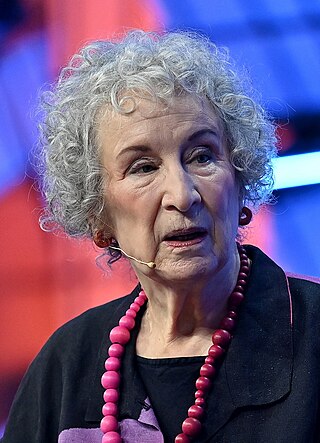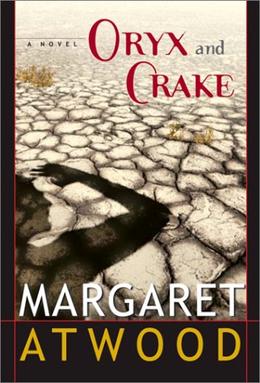
Judith Blume is an American writer of children's, young adult, and adult fiction. Blume began writing in 1959 and has published more than 25 novels. Among her best-known works are Are You There God? It's Me, Margaret. (1970), Tales of a Fourth Grade Nothing (1972), Deenie (1973), and Blubber (1974). Blume's books have significantly contributed to children's and young adult literature. She was named one of the 100 most influential people in the world by Time magazine in 2023.

Margaret Eleanor Atwood is a Canadian poet, novelist, literary critic, essayist, teacher, environmental activist, and inventor. Since 1961, she has published eighteen books of poetry, eighteen novels, eleven books of non-fiction, nine collections of short fiction, eight children's books, two graphic novels, and a number of small press editions of both poetry and fiction. Atwood has won numerous awards and honors for her writing, including two Booker Prizes, the Arthur C. Clarke Award, the Governor General's Award, the Franz Kafka Prize, Princess of Asturias Awards, and the National Book Critics and PEN Center USA Lifetime Achievement Awards. A number of her works have been adapted for film and television.

The Handmaid's Tale is a futuristic dystopian novel by Canadian author Margaret Atwood published in 1985. It is set in a near-future New England in a patriarchal, totalitarian theonomic state known as the Republic of Gilead, which has overthrown the United States government. Offred is the central character and narrator and one of the "Handmaids", women who are forcibly assigned to produce children for the "Commanders", who are the ruling class in Gilead.

The Blind Assassin is a novel by the Canadian writer Margaret Atwood. It was first published by McClelland and Stewart in 2000. The book is set in the fictional Ontario town of Port Ticonderoga and in Toronto. It is narrated from the present day, referring to previous events that span the twentieth century but mostly the 1930s and 1940s. It is a work of historical fiction with the major events of Canadian history forming an important backdrop, for example, the On-to-Ottawa Trek and a 1934 Communist rally at Maple Leaf Gardens. Greater verisimilitude is given by a series of newspaper articles commenting on events and on the novel's characters from a distance.

Oryx and Crake is a 2003 novel by Canadian author Margaret Atwood. She has described the novel as speculative fiction and adventure romance, rather than pure science fiction, because it does not deal with things "we can't yet do or begin to do", yet goes beyond the amount of realism she associates with the novel form. It focuses on a lone character called Snowman, who finds himself in a bleak situation with only creatures called Crakers to keep him company. The reader learns of his past, as a boy called Jimmy, and of genetic experimentation and pharmaceutical engineering that occurred under the purview of Jimmy's peer, Glenn "Crake".

Are You There God? It's Me, Margaret. is a middle-grade novel by American writer Judy Blume, published in 1970. Its protagonist, Margaret Simon, is a sixth-grader who grows up without a religious affiliation because of her parents' interfaith marriage. This contemporary realistic novel was popular with middle-grade readers in the 1970s for its relatable portrayal of a young girl confronting early-adolescent anxieties, such as menstruation, brassieres and boys. The recipient of national honors and book awards, the novel has been challenged for its frank discussion of sexual and religious topics.

Alias Grace is a historical fiction novel by Canadian writer Margaret Atwood. First published in 1996 by McClelland & Stewart, it won the Canadian Giller Prize and was shortlisted for the Booker Prize.
A snowman is a temporary sculpture made of snow. Snowman or snowmen may also refer to:
Allan Sparrow was a Canadian political activist and long standing city councillor in Toronto. He was instrumental in stopping the Spadina Expressway, setting up civilian oversight of the Toronto Police, promoting cycling in Toronto and gay rights. He was also instrumental in the cancellation of a proposed bridge to the Toronto Island Airport.
Abominable Snowman is a common name for the Yeti, an apelike animal cryptid said to inhabit the Himalaya region of Nepal and Tibet.

Payback: Debt and the Shadow Side of Wealth is a non-fiction book written by Margaret Atwood, about the nature of debt, for the 2008 Massey Lectures. Each of the book's five chapters was delivered as a one-hour lecture in a different Canadian city, beginning in St. John's, Newfoundland, on October 12 and ending in Toronto on November 1. The lectures were broadcast on CBC Radio One's Ideas November 10–14. The book was published by House of Anansi Press, both in paperback and in a limited edition hardcover.
Geraldine Bedell is a British novelist and writer for The Observer.

Climate fiction is literature that deals with climate change. Generally speculative in nature but inspired by climate science, works may take place in the world as we know it, in the near future or in fictional worlds experiencing climate change. The genre frequently includes science fiction and dystopian or utopian themes, imagining the potential futures based on how humanity responds to the impacts of climate change. The genre typically focuses on anthropogenic climate change and other environmental issues as opposed to weather and disaster more generally. Technologies such as climate engineering or climate adaptation practices often feature prominently in works exploring their impacts on society.

MaddAddam is a novel by Canadian writer Margaret Atwood, published on 29 August 2013.
Orville Stoeber is an American singer/songwriter, actor and artist.

The Testaments is a 2019 novel by Margaret Atwood. It is the sequel to The Handmaid's Tale (1985). The novel is set 15 years after the events of The Handmaid's Tale. It is narrated by Aunt Lydia, a character from the previous novel; Agnes, a young woman living in Gilead; and Daisy, a young woman living in Canada.

A climate apocalypse is a term used to denote a predicted scenario involving the global collapse of human civilization due to climate change. Such collapse is hypothesized to arrive through a set of interrelated concurrent factors such as famine, extreme weather, war and conflict, and disease.
Syima Aslam Hon. FRSL is the CEO, Artistic Director and Founder of the Bradford Literature Festival.
Ecofeminism generally is based on the understanding that gender as a concept is the basis of the human-environment relationships. Studies suggest that there's a difference between men and women when it comes to how they treat nature, for instance, women are known to be more involved with environmentally friendly behaviors. Socially there's an important claim in the ecofeminism theoretical framework that the patriarchy is linked to discrimination against women and the degradation of the environment. In Canada the United Nations Special Rapporteur on Human Rights and Toxics in 2020 shows that ineffective environmental management and mismanagement of hazardous waste is affecting different age groups, genders, and socioeconomic status in different ways, while three years before that, Canadian Human Rights Commission in 2017 submitted another report, warning the government about how the exposure to environmental hazards is a different experience for minorities in Canada. There have been ecofeminist movements for decades all over Canada such as Mother's Milk Project, protests against Uranium mining in Nova Scotia, and the Clayoquot Sound Peace Camp. Ecofeminism has also appeared as a concept in the media, such as books, publications, movies, and documentaries such as the MaddAddam trilogy by Margaret Atwood and Fury for the Sound: the women at Clayoquot by Shelley Wine. Ecofeminism in the Canadian context has been subject to criticism, especially by the Indigenous communities as they call it cultural appropriation, non-inclusive, and inherent in colonial worldviews and structures.













